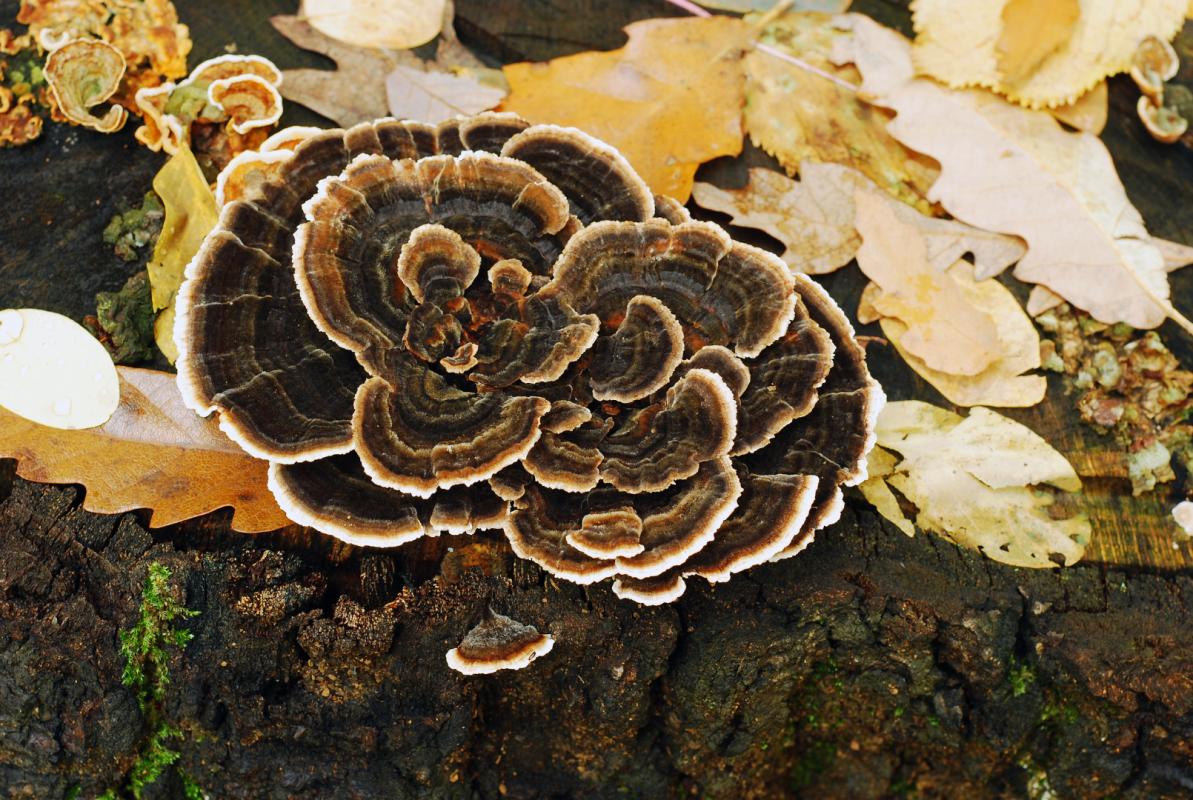Plant Medicine, Turkey Tail Mushroom
Turkey Tail Mushrooms: Unlocking Nature’s Pharmacy Through Its Healing Powers
Turkey tail mushrooms, scientifically known as Trametes versicolor, have been used for centuries in traditional medicine for their potential health benefits.
These multicolored fungi, resembling a turkey’s tail, are abundant in various parts of the world and have gained attention for their immune-boosting and potential cancer-fighting properties. Let’s delve into the benefits, usage, recipes, and side effects of this medicinal plant, making it relatable and appealing to plant medicine users.
Understanding the Benefits
1. Immune-Boosting Properties
Research has shown that the mycelium of the turkey tail mushroom exhibits potent immune-activating properties, enhancing both innate and adaptive immune responses. Compounds such as polysaccharopeptide (PSP) and polysaccharide-K (PSK) found in turkey tail mushrooms have been linked to immune modulation and potential cancer treatment support. Additionally, a scoping review indicated that turkey tail played a role in prolonging overall survival in gastric cancer patients.
2. Cancer Treatment Support
Turkey tail mushrooms have been used as a supportive therapy in cancer treatment, particularly in Japan, where a preparation made from these mushrooms, known as krestin, has been utilized for decades. Studies have suggested that turkey tail extract may inhibit colon cancer cell growth, and it has been associated with potential benefits in various types of cancer, including breast, lung, gastric, pancreatic, and liver cancer.
3. Gut Health and Digestive Harmony
4. Respiratory Support
Side Effects and Precautions
While turkey tail mushrooms are generally considered safe for consumption, it’s crucial to be aware of potential side effects and precautions. Always consult a healthcare provider before using any new supplement, especially if you have underlying health conditions or are taking medications. Some individuals may experience allergic reactions or digestive discomfort, and interactions with certain medications are possible
In conclusion, turkey tail mushrooms have garnered attention for their potential as a plant medicine, particularly in the realms of immune support and cancer treatment. As with any natural remedy, it’s essential to approach their usage with caution and seek guidance from healthcare professionals. Whether incorporated into a daily supplement routine or utilized in culinary creations, the unique properties of turkey tail mushrooms make them a fascinating subject in the world of plant medicine.
By providing a comprehensive overview of the benefits, usage, recipes, and precautions associated with turkey tail mushrooms, this article aims to empower plant medicine users with valuable insights into this intriguing natural remedy.
Turkey Tail Mushroom Consumption
There are several different ways to consume turkey tail mushrooms, each offering unique benefits and versatility. Here are the various methods of consumption:
1. TEA
One of the most common ways to consume turkey tail mushrooms is by preparing a tea. This method involves boiling the mushrooms and then straining them out to create a concentrated turkey tail tea. This allows for the extraction of beneficial compounds using just water, making it an accessible and straightforward way to enjoy the potential health benefits of turkey tail mushrooms.
2. SUPPLEMENTS
Turkey tail mushrooms are also available in supplement form, such as capsules or extracts. This method provides a convenient and concentrated way to incorporate the medicinal properties of turkey tail mushrooms into one’s daily routine. It’s important to consult a healthcare professional before incorporating any supplements into your regimen, especially if undergoing medical treatment.
3. CULINARY USE
Fresh turkey tail mushrooms can be used in various recipes, including soups, stir-fries, and sauces. They are versatile and pair well with other ingredients such as garlic, onions, and thyme. When cooking with fresh turkey tail mushrooms, it’s important to prepare them properly by washing them thoroughly and removing any debris or dirt. They can be sliced thinly or chopped into small pieces, depending on the recipe.
4. SMOOTHIES AND SOUPS
Dried whole turkey tail mushrooms can be added to smoothies or used to make extracts and tinctures. Additionally, they can be incorporated into soups, adding a unique flavor profile and potentially providing health benefits
Each method of consumption offers a distinct way to experience the potential benefits of turkey tail mushrooms, whether through a soothing tea, convenient supplements, or as a flavorful addition to culinary creations. It’s important to consider individual preferences and consult with a healthcare professional to determine the most suitable approach for incorporating turkey tail mushrooms into one’s wellness routine.
Embracing the Wisdom of Nature
Turkey Tail mushrooms, with their diverse array of benefits, offer a gateway to holistic wellness. Whether sipped as a tea, savored in a culinary creation, or taken as a supplement, these fungi have much to offer those seeking natural remedies.
As plant medicine enthusiasts continue to explore the vast world of herbal remedies, the Turkey Tail mushroom stands as a testament to the healing powers found within the embrace of nature’s pharmacy. So, embark on this journey, let the mushrooms guide you, and discover a new dimension of well-being.

